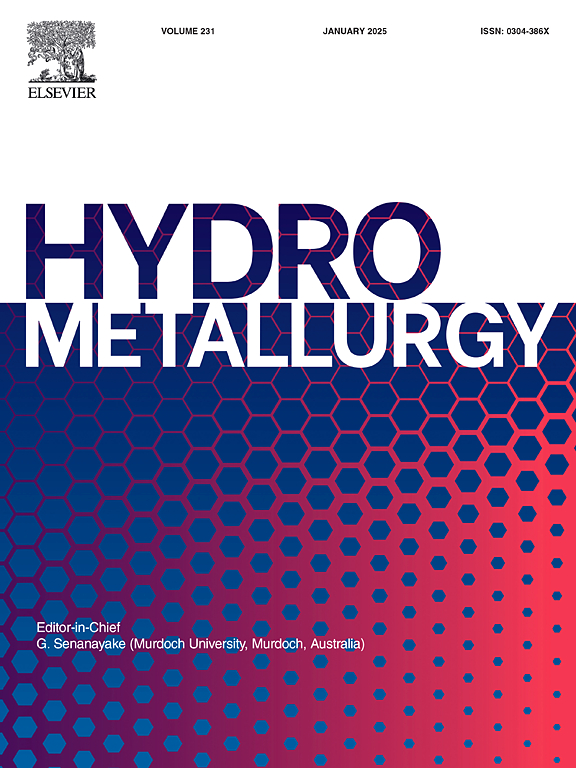Separation of aluminum and lithium in sulfuric acid roasting leachate of overhaul slag by Di-(2-ethylhexyl) phosphoric acid extraction and sulfuric acid stripping
IF 4.8
2区 材料科学
Q1 METALLURGY & METALLURGICAL ENGINEERING
引用次数: 0
Abstract
The sulfuric acid roasting – water leaching - solvent extraction process is an effective method for extracting aluminum and lithium from overhaul slag. This study aims to investigate the extraction behavior of di-(2-ethylhexyl) phosphoric acid (P204) of molecular formula C16H35O4P in sulfonated kerosene for Al3+, Li+ in sulfuric acid media. Under the most suitable conditions of pH 2.7, organic and aqueous phase volume ratio (O/A) of 1, P204 concentration of 50 % (v/v), extraction time of 5 min, the selective extraction efficiency of aluminum reached 99.1 % after 3 stages. The loss of lithium was 6.2 %, with a separation factor (β(Al/Li)) of 4295. The aluminum-bearing organic phase was stripped with 20 % sulfuric acid, at an O/A phase ratio of 1. The recovery of aluminum attained 98.6 % after a stripping time of 4 min. Then, the organic phase was recycled and the inorganic phase was prepared to produce Al2(SO4)3. Finally, the high Al3+ concentration of 11.5 g/L in the acid roasting leachate of overhaul slag was reduced to 4.24 × 10−3 g/L.
二-(2-乙基己基)磷酸萃取-硫酸汽提分离大修渣硫酸焙烧浸出液中的铝锂
硫酸焙烧-水浸-溶剂萃取工艺是从检修渣中提取铝和锂的有效方法。研究了分子式为C16H35O4P的二-(2-乙基己基)磷酸(P204)在磺化煤油中对硫酸介质中Al3+、Li+的萃取行为。在pH为2.7、有机水相体积比(O/A)为1、P204浓度为50% (v/v)、萃取时间为5 min的条件下,经过3级萃取,铝的选择性萃取效率达到99.1%。锂的损失率为6.2%,分离因子(β(Al/Li))为4295。含铝有机相用20%硫酸在O/A相比为1的条件下进行剥离。溶出时间为4 min后,铝的回收率达到98.6%。然后将有机相回收,制备无机相制备Al2(SO4)3。最终,大修渣酸焙烧渗滤液中Al3+浓度从11.5 g/L降至4.24 × 10−3 g/L。
本文章由计算机程序翻译,如有差异,请以英文原文为准。
求助全文
约1分钟内获得全文
求助全文
来源期刊

Hydrometallurgy
工程技术-冶金工程
CiteScore
9.50
自引率
6.40%
发文量
144
审稿时长
3.4 months
期刊介绍:
Hydrometallurgy aims to compile studies on novel processes, process design, chemistry, modelling, control, economics and interfaces between unit operations, and to provide a forum for discussions on case histories and operational difficulties.
Topics covered include: leaching of metal values by chemical reagents or bacterial action at ambient or elevated pressures and temperatures; separation of solids from leach liquors; removal of impurities and recovery of metal values by precipitation, ion exchange, solvent extraction, gaseous reduction, cementation, electro-winning and electro-refining; pre-treatment of ores by roasting or chemical treatments such as halogenation or reduction; recycling of reagents and treatment of effluents.
 求助内容:
求助内容: 应助结果提醒方式:
应助结果提醒方式:


